Are you ready to make your own cannabis-infused oil? You’re in the right place if you want something easy and effective. This step-by-step beginner’s guide will teach you how to make cannabis-infused MCT oil at home. Once made, this oil is versatile and can be used as a sublingual oil or a base for many cannabis-infused recipes and topical preparations.
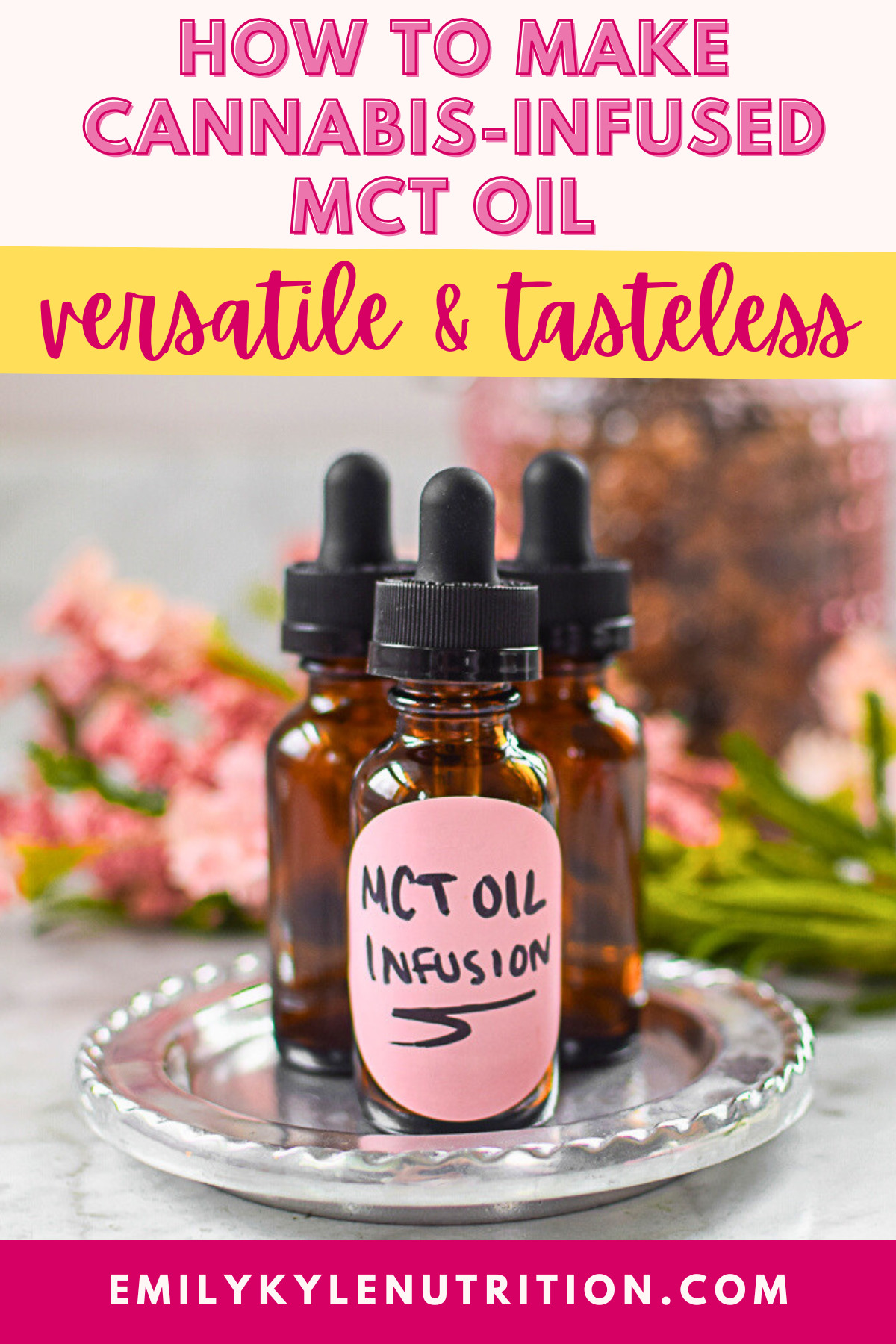
Table of Contents
Article Features
- Just two ingredients: cannabis flowers & MCT oil
- No special equipment – just a crockpot and mason jars
- Want to make it easy? Skip the hard work, order my Bliss MCT Oil, and have it delivered straight to your door – now shipping across the United States!
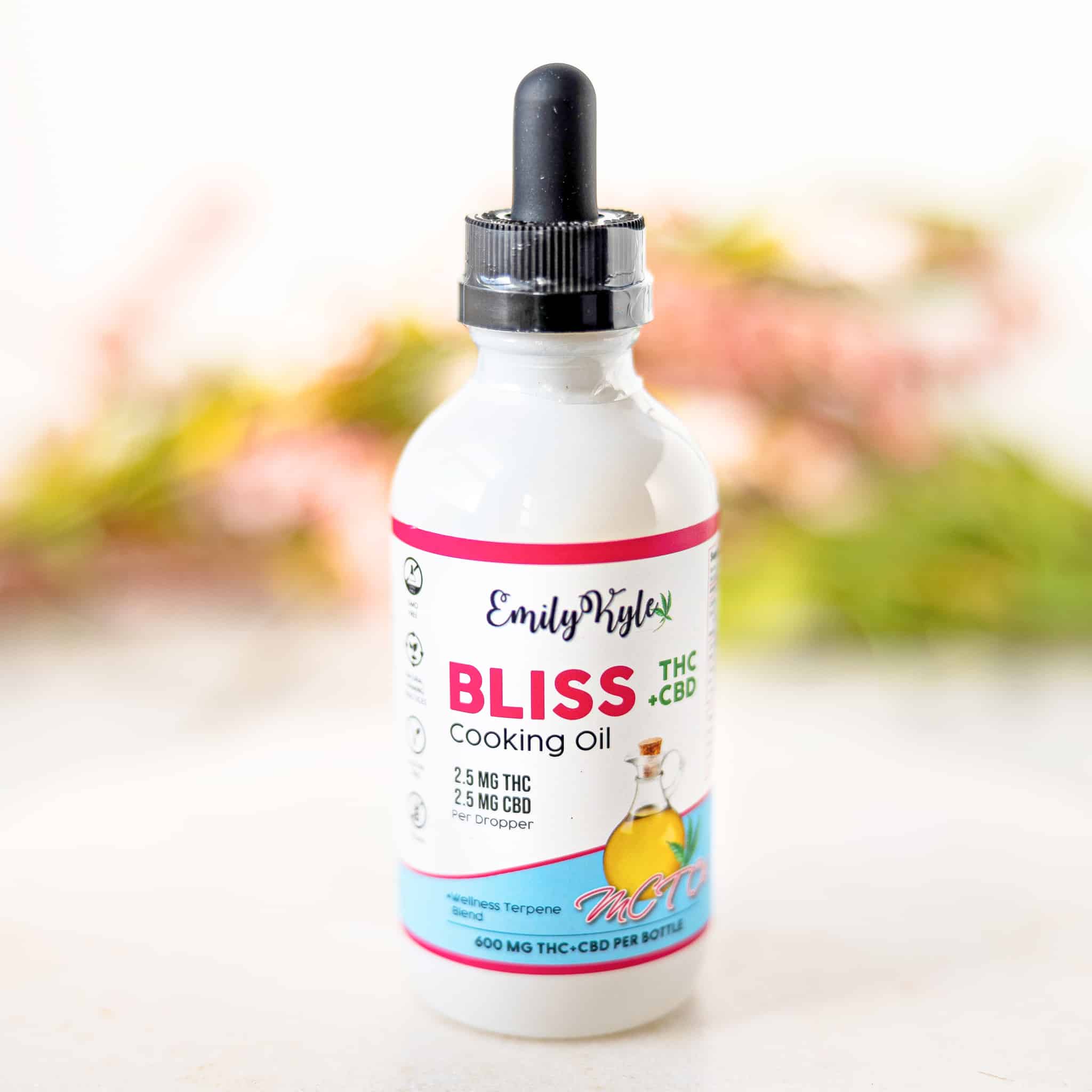
Why You Will Love This Recipe
Cannabis-infused MCT oil is a popular type of oil infusion made with two simple ingredients: cannabis flowers and MCT oil.
MCT oil is a type of fat extracted from coconuts. They are rapidly digested and absorbed by the body.
MCT oil remains liquid at room temperature, is completely clear, and has no flavor, making it one of the reasons it is so popular in my Well With Cannabis Community.
Many members love that this infusion can be used either sublingually held under the tongue or in homemade edibles.
In this guide, I will show you my super easy process for infusing MCT oil and talk about some important tips and tricks to help you on your cannabis journey.
What You’ll Need

- MCT oil – a clear, tasteless oil. You can learn more about the benefits and drawbacks of MCT oil below. You can purchase MCT oil here.
- Cannabis flowers – You will need your desired amount of cannabis flowers, ranging from 3.5 grams to 1 ounce. You can purchase hemp flowers from my online shop.
- Lecithin, optional: If you’re new to working with lecithin, you can learn more about adding lecithin to edibles. If needed, you can purchase liquid or powdered. This ingredient is optional.
Note: A complete list of ingredients with amounts and printable instructions is located on the recipe card below.
The Step-by-Step Process

- Step 1 – The goal is to create a water bath that stays at approximately 180-190° F for the cooking process. The printable instructions in the recipe card below are for using a crockpot to create the water bath.
- Step 2 – While the water bath is heating in the crockpot, measure and decarb the cannabis flower. Learn how to decarb in an oven or decarb in an Instant Pot.
- Step 3 – Evenly divide the decarbed cannabis flower and MCT oil between the mason jars you plan on using. If you plan on using sunflower lecithin, add it to the mason jars now.
- Step 4 – Carefully place the jars into the water bath. Then, leave the lid on the crockpot alone to infuse for 4 hours. After 4 hours, remove the jars from the hot water and allow them to cool.
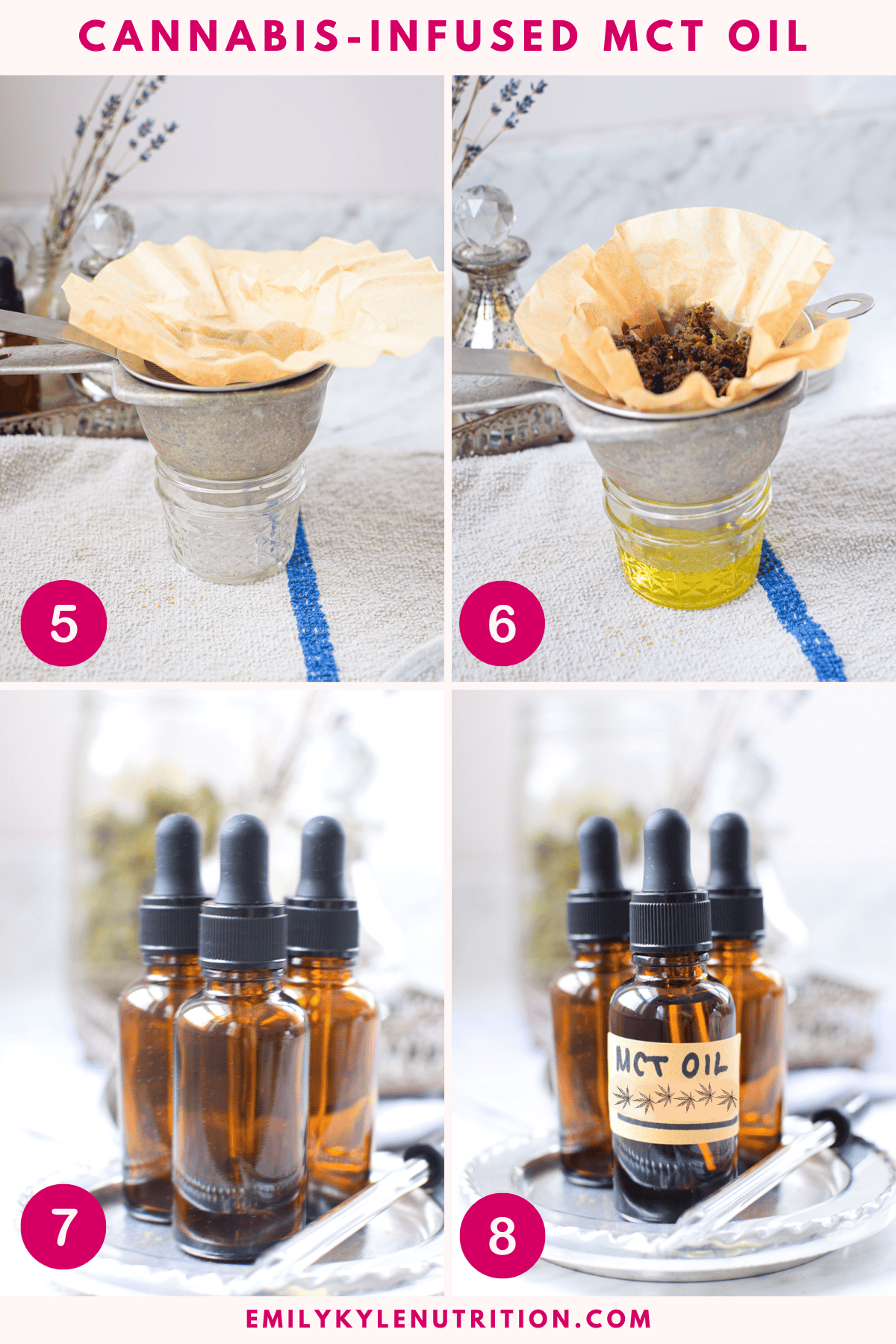
- Step 5 – Whether it be a paper filter and funnel, cheesecloth, French press, or a simple coffee filter, you will want to set up a straining station to separate the plant matter from the oil.
- Step 6 – Once cool enough to handle, strain the prepared oil with your method of choice. You can save the leftover cannabis pulp for future recipes.
- Step 7 – Return the prepared oil to whatever jar you want to store it in; I use a small amber tincture dropper bottle.
- Step 8 – Store the prepared oil in a cool, dry place. It will last longer if stored in the refrigerator and even longer if stored in the freezer.
Note: Complete step-by-step printable instructions are located in the printable recipe card below.
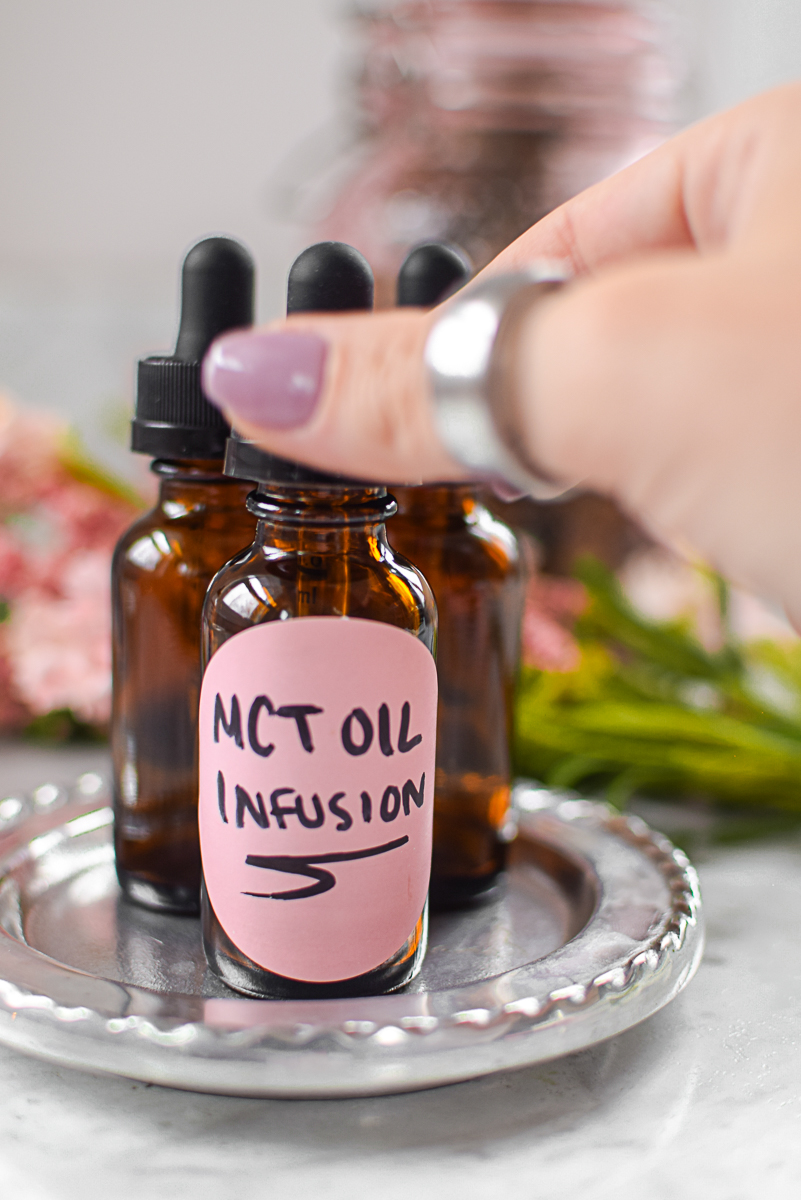
Storage Instructions
Store your prepared MCT oil in a cool, dry place.
It will last longer if stored in the refrigerator and even longer if stored in the freezer.
Learn more about how to properly store edibles and tinctures here.
Is MCT Oil a Tincture?
I’ve seen many people, including those inside my cannabis community, fuss over the terminology of a tincture.
Technically, a tincture is an alcohol-based preparation, like the Green Dragon or a QWET tincture.
Because it is not made with alcohol, this cannabis MCT oil preparation is considered an infusion, not a tincture.
However, you’ll often see people refer to MCT oil as tinctures simply because they are oftentimes held under the tongue for sublingual application.
It is important to note that there is a difference in effect between holding a tincture under your tongue vs. simply swallowing it.
While the difference is small, the effects can be quite noticeable from other application methods.
Sublingual Use for MCT Oil
Sublingual simply means under the tongue.
This method involves holding oil or tincture under your tongue so your mucous membranes can absorb it.
There is a dense concentration of capillaries under the tongue and around the mouth, so products held in the mouth are delivered directly to the bloodstream1.
Many people like this method because the typical onset time starts fairly quickly, between 15-30 minutes.
The typical duration time lasts for an average of 2-4 hours.
Edible Use of MCT Oil
You can consume edibles in many different forms, including:
Eating cannabis is a bit more complicated than simply placing it under the tongue.
This is because the cannabinoids we ingest pass through our digestive system.
During digestion, THC is absorbed into the bloodstream and travels to the liver, where it undergoes the hepatic first-pass metabolism.
This process converts THC into a different form, now 11-OH-THC, a potent psychoactive metabolite that easily crosses the blood-brain barrier2.
This explains why eating cannabis can provide stronger, more potent, or intoxicating effects for many people.
This is why it is so important to follow the golden dosing rule: start low and go slow.
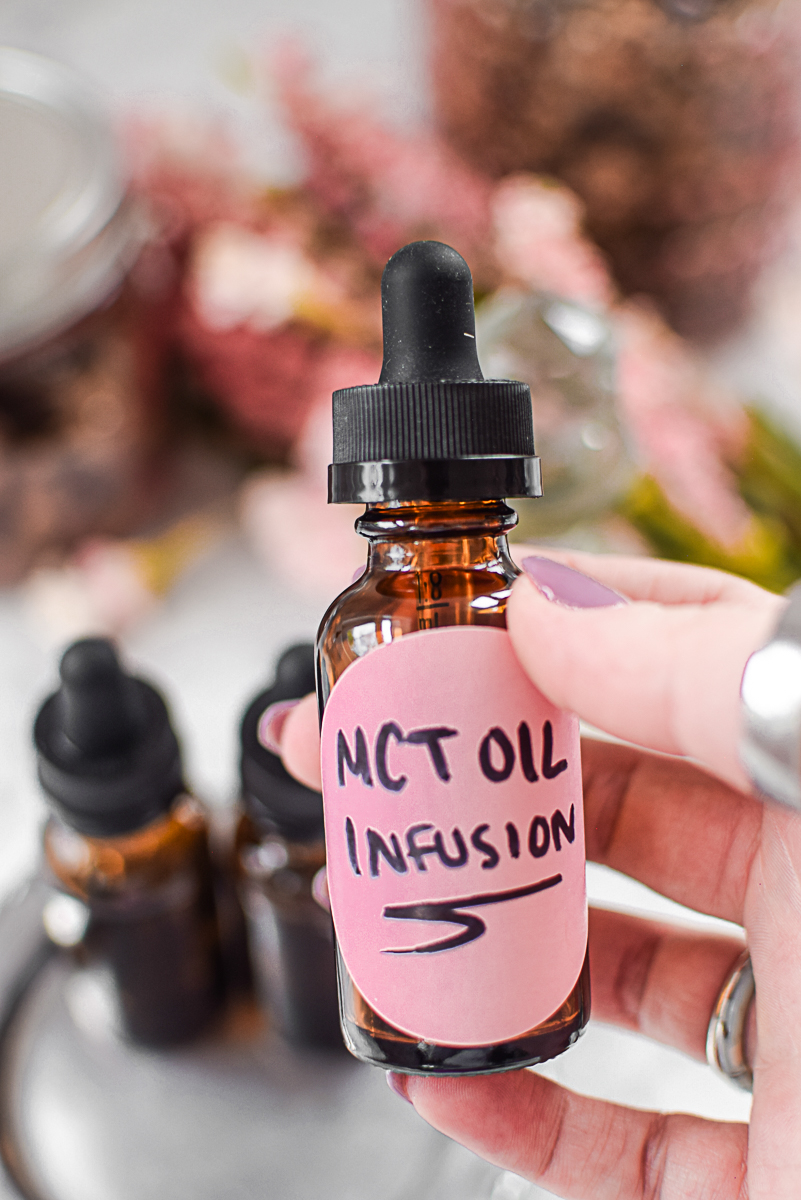
MCT Oil vs. Coconut Oil
It is important to note there are some differences between MCT oil and coconut oil.
You will notice this primarily when baking or using oil in recipes.
While both are derived from coconuts, there is a noticeable taste and texture difference between the two.
Coconut Oil vs.
- Refined has no flavor, and unrefined has a slight coconut flavor
- Solid at room temperature
- Opaque when solid
- Refined has no flavor, and unrefined has a slight coconut flavor
- Easy to substitute in baked goods
- Not great for sublingual application
- May cause digestive distress in large amounts
- High smoke point, 350° F, great for cooking
MCT Oil
- Derived from coconut
- Liquid at room temperature
- Remains clear
- Has no flavor
- Not as easy to substitute in baked goods
- Great for sublingual applications
- May cause digestive distress in large amounts
- Low smoke point, 284° F, not good for cooking
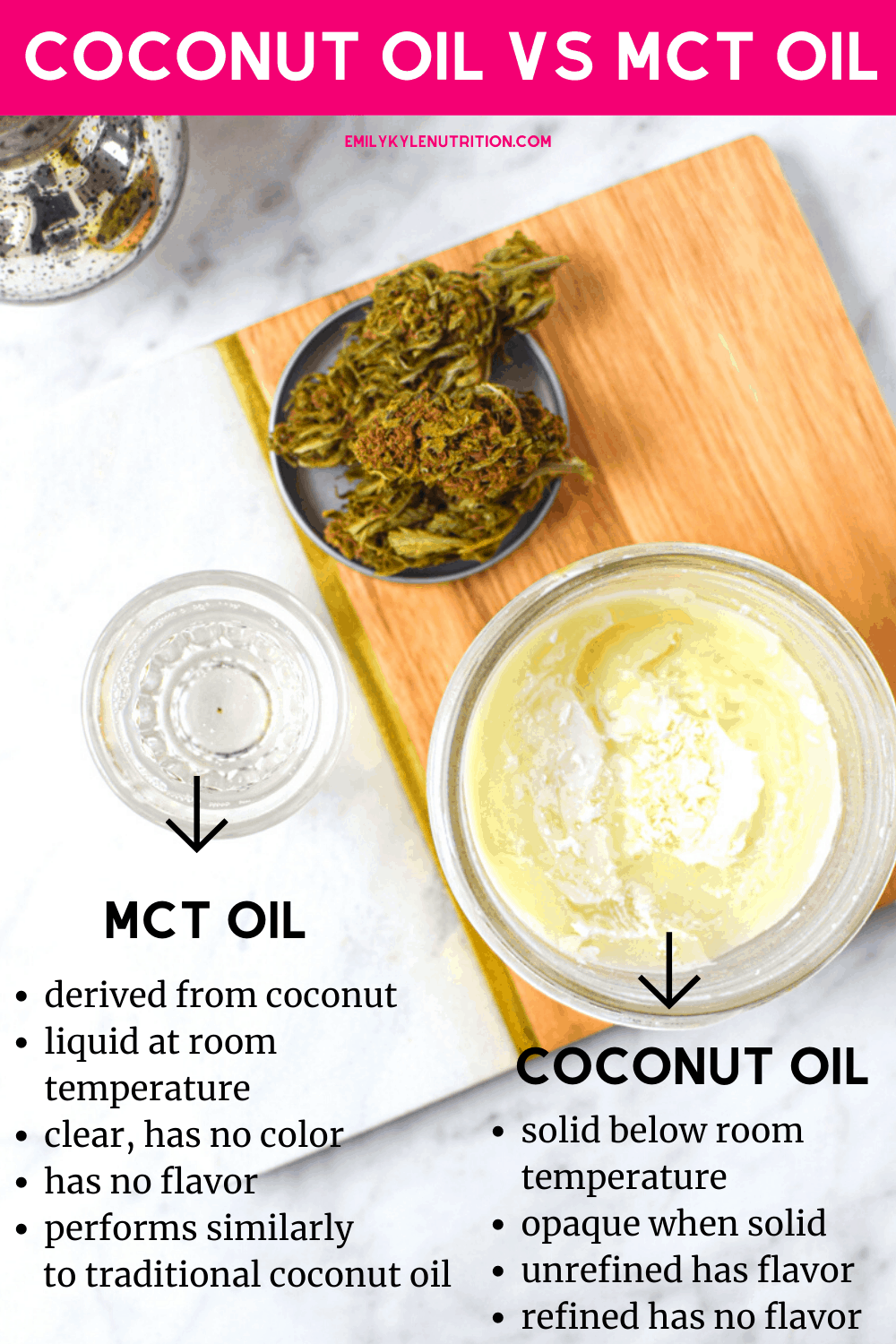
MCT Oil and Digestive Distress
One important thing to note is that MCT oil in large amounts may cause digestive distress in some individuals.
Many members of my cannabis community have reported that consuming too much MCT oil, either in an edible or sublingually, causes digestive problems.
MCT oil may cause diarrhea, vomiting, bloating, and cramping because it is metabolized differently by the body.
Additionally, it is not recommended for individuals who have liver problems.
⚠️ That is why it is important to start low and go slow, just like all things cannabis; that way, you can see how your body reacts.

How to Make Cannabis-Infused MCT Oil
Ingredients
- 16 ounces MCT oil
- 1 ounce decarbed cannabis flower
- 1 teaspoon liquid sunflower lecithin
Instructions
- Fill your crockpot with enough warm to hot water to cover the top of the mason jars you plan on using by an inch to create a water bath.
- Place the digital thermometer into the water. Start the crockpot heat on high. When a temperature of 185° F is reached, turn the crockpot to low.digital thermometer
- While the water bath is heating in the crockpot, measure and decarb the cannabis flower. Click here for a full cannabis decarboxylation tutorial, if needed.
- If you plan on using sunflower lecithin, add it to the mason jars now.
- Evenly divide the decarbed flower between the MCT oil filled jars. Stir well. Wipe the rim of the jars with a clean paper towel and place the lid on. Tighten the metal ring to finger-tip tightness, it does not have to be tightened all the way. Do not tighten too tightly.
- Once the water bath reaches a temperature of 185° F, carefully place the jars into the water bath.
- Place the lid on the crockpot and leave it alone to infuse for 4 hours.
- After 4 hours, carefully remove the lid, followed by the jars from the hot water. Set them aside to cool.
- Save the leftover cannabis pulp for use in future recipes. Then return the prepared cannabis oil to whatever jar you would like to store it in. We use a small amber tincture jar.
- Store the prepared cannabis MCT oil in a cool, dry place. It will last longer if stored in the refrigerator and even longer if stored in the freezer.
Notes
- Yield: ~16 ounces / ~2 cups
- Temperature Control: The water bath does not need to stat perfectly at 185° F the entire time. Any temperature between 170°-190°F is OK.
- Safety First: I recommend you sanitize your jars by keeping them submerged in the 185° F crockpot for 10 at least minutes. This step is not necessary, but good practice for safety and hygiene.
- Floating Jars: Sometimes the mason jar will float when placed in the water bath. This is no need for concern, simply put something heat and water safe over the top of the jar to weigh it down, a clean rock works well.
- Alternative Carrier Oil Options Include:
- Olive oil
- Avocado oil
- Hemp seed oil
- Grapeseed oil
- Coconut oil
Nutrition
Frequently Asked Questions
You can use my free edible dosage calculator to get a guestimate of how potent your MCT oil infusion will be. You can use my dosing guide from there to know how much to take. If you’re new to cannabis, consider starting with a microdose option.
You may want to consider making a small test batch before making a larger batch. This recipe calls for 1 ounce of flower and 16 ounces of MCT oil, which will yield a large batch. If you want to make a smaller batch first to see if MCT oil infusions are right for you, use this cannabis flower-to-oil ratio guide.
If you want a stronger, more potent infusion, you can make this MCT oil infusion with FECO. Follow the directions for making FECO here, including directions for mixing with MCT oil after cooking. You can also make infused MCT oil with other types of cannabis concentrates.

Take your edibles to the next level…
My Edibles Made Easy Online Cooking Course will teach you how to easily make cannabis edibles and topical recipes at home. This step-by-step video course will teach you how to infuse, extract, and create edibles with many different product types – all from the comfort of your own home.
More Guides You Will Love
All Things Cannabis Oil
Discover the Many Types of Cannabis Oil Infusions
Articles & How-To Guides
Cannabis Flower-to-Oil Ratio Guide & Printable Chart
Cannabis Infusions & Extractions
Easy Cannabis Coconut Oil Recipe
Cannabis Infusions & Extractions

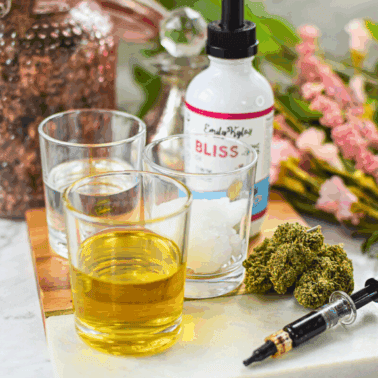
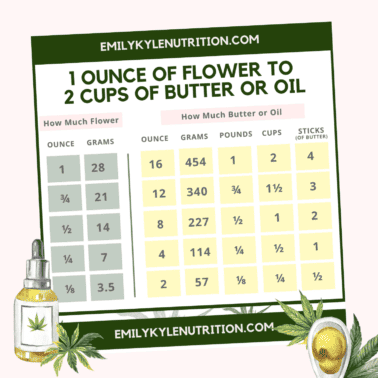
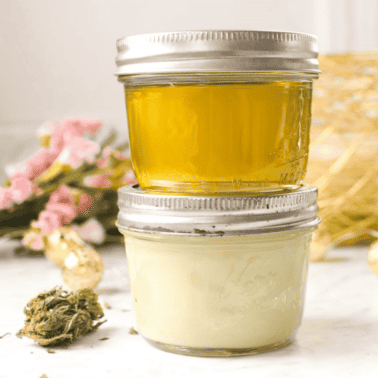
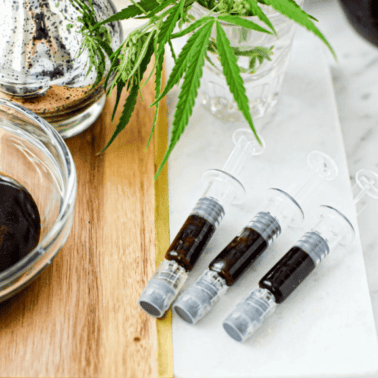
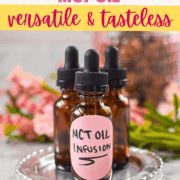








could I add a few drops of peppermint extract for a bit of taste?
Hey Paul. Yes, you can absolutely add a few drops of peppermint extract for a bit of taste! 🍃 Just be sure to start with a small amount and adjust to your liking. I hope it turns out perfectly for you!
A question. Can mct oil that’s been infused be infused twice to increase potency
Yes, MCT oil that has been infused can typically be infused again to increase potency. Just be mindful of how much plant material you’re using to ensure the final product meets your desired strength. 🌿
Can wait to try this
We’d love to hear your results!
MCT OIL POWDER, can it be infused?
Yes, MCT oil powder can be infused! It works great in recipes like coffee, smoothies, and baked goods. You can try this recipe to help you get started: https://emilykylenutrition.com/cannabis-oil-powder/
Hello. Love your page. Can you used ground, already vaped weed for this recipe? I’d assume so. Will the flavor be affected in a negative way? Especially if used in gummies? I don’t mind a bit of weed taste in recipes, but it may not be suited for gummies.
Lastly, about how much (%) of thc does AVB (vaped bud) lose? Say your strain is 20%. I’ve been just guessing it drops to about 7-8%. Idk if I’m way off or not. Thank you very much!
Thank you for your comment, Tyler! Yes, you can use already vaped bud (AVB) for this recipe. The flavor may be stronger and more noticeable, which might not be ideal for gummies, but it’s all about personal preference. As for THC potency, AVB typically retains around 5-10% of its original THC, so your estimate is pretty close! Hope this helps, and happy cooking! 🌱
Thank you for those very informative articles and recipes. I have 2 questions about the process. I wondered why you specified using 2 mason jars, splitting the ingredients between the 2. Wouldn’t this work if one larger mason jar is used? My second question is about the color of the resulting canna oil. I followed a recipe from another site (before I found yours!), which gave the same proportion of ingredients, but advised a temperature of 220 degrees for 90 minutes. The resulting oil is very dark green and has a strong taste. Have I done something wrong? The photos here show a much lighter-colored oil. BTW, I used MCT oil.
Thank you for your questions! Using two mason jars helps ensure the ingredients are evenly infused and fits better in most setups. A darker green oil and strong taste typically come from chlorophyll extraction, which can happen at higher temps or with certain strains, but not necessarily avoidable. Hope this helps! 😊
Hi Emily! How do I go about making *REALLY* potent MCT? I’ve been decarbing flower in oven (25 minutes @ 250°F), then infusing with MCT and liquid sunflower lecithin in sous vide water bath (6 hours @ 185°F in mason jar). Recipe is 1 oz flower, 1 cup oil, 1 tsp lecithin. Sometimes I’ll infuse a second time for 4 hours the next day. It’s ok, but I want it to the point where 1 tablespoon medicates me how I want. Right now I need like 2-3 (too many calories which is why I care).
So, can I saturate oil with THC to the point that adding more flower or more time has no benefit? Is there a limit to how much flower I can use in 1 cup of oil, or how long I infuse for? My normal route of ingestion is simply topping off a cup of coffee with infused MCT – would coconut oil work better? It’s good flower, sun grown summer run so I have plenty at my disposal, Barney’s Farm genetics.
Guide me Emily! How should I go about maxing out potency per tablespoon? Thanks so much, big fan of the website!
Hi Kevin! To maximize potency, you can pack more flower into the oil, but there is a saturation point—roughly 1 oz of flower per cup of oil is a good balance. Extending infusion time beyond 6-8 hours typically doesn’t add much benefit. Coconut oil might work slightly better for potency absorption due to its higher fat content, but MCT oil is great too. For less volume and higher potency, consider using concentrates like rosin instead of flower. Hope that helps, and thanks for the kind words!
What is the best oil to infuse for gummies
Hi Daniel. Coconut oil is commonly recommended because it is easy to infuse, has a mild flavor, and pairs well with the gummy texture. You can also use MCT oil or another neutral oil if you prefer.
Just saw a bag of MCT POWDER next to the bottles of oil. Has anybody figured out how to infuse that? Wondering if powdered decarbed weed mixed with MCT powder is THE WAY????????
IDEAS?
Hi Joh. While we haven’t tried using flower to mix with powder, we have successfully made cannabis powder with oil. You might find this guide helpful: https://emilykylenutrition.com/cannabis-oil-powder/. It dives into how to make cannabis oil powder and could be exactly what you’re looking for to experiment with MCT powder and decarbed weed. Definitely worth checking out!
Why do you decarboxylate before you put it in a bath at 190 for 4 hours. It seem redundant.
Great inquiry, Wally. Decarboxylation activates compounds like THC or CBD, making them more effective. While the 190°F bath helps with infusion, it’s typically not hot enough to fully decarb the material. Decarbing beforehand ensures maximum potency in the final product.
I accidently turned my crock pot on high, and it was at boil when I checked, about an hour later. Is this batch savable? The THC was 24.54% before I started.
Fingers crossed; I am hoping for a positive reply. I tell all my friends about your site; I think it’s great.
Hi David. Thank you for sharing your love of our site with others! This batch is definitely savable. If anything, the THC may have converted to CBN, which will cause sleepier results than usual, but definitely not wasted.
When you decarb Emily, what percentage do you count as waste? With my Ardent I usually just figure I will get 85% of the available THCa to turn into THC and be usuable for my recipes.
And would you know how efficient hemp seed oil is as an infusion base? Olive oil I figure about 85% when I am done infusing, and MCT oil is usually a bit less for me, it seems, so I figure 80%.
Thank you!
Hi Derek. When decarbing cannabis, the typical potency/weight loss is around 12%, meaning you’ll get approximately 88% of the available THCA converting to THC. This is close to your estimate using the Ardent.
As far as the most efficient carrier for infusing with cannabis, you want to look at the oil with the most saturated fat, which is coconut or MCT oil. Hemp seed oil is a good option, as it has a high amount of omega fatty acids which can help boost the absorption of cannabinoids.
Happy infusing, and let us know if you have any other questions!
Hi Emily, I have a magical butter type infusion machine, I’m planning on making mct oil, but the device recommends infusing for 1 hour, but I notice your recipe recommends 4 hours, the machine allows you to add extra time, would you recommend using the machine for 4 hours or the 1 hour that it recommends?
Hey there! When it comes to infusing with your magical butter-type machine, its ultimately personal preference, but I recommend following my recipe’s suggestion of 4 hours for a more thorough infusion. It can make a slight difference in the potency. Happy infusing! 🌿
Can you use the same procedure for infusing butter as you do for MCT oil? If not why? I’m specifically curious if the temperatures of the inside of the instant pot on high pressure are too high for infusing mct oil.
Yes, Zachariah, you can use the same procedure for infusing butter as you do for MCT oil, but it’s important to note that you shouldn’t use the pressure-cook option for the infusion process. Instead, after decarboxylating your cannabis under high pressure, switch to the slow cook option for infusion. This uses a lower temperature, which is better suited for both MCT oil and butter infusions. Happy infusing!
Learning more everyday – have an Ardent mini & have only infused evoo once & made gummies but think my ratio is off. Would like a faster response also & not wait 3 hours to kick in & wondering how tinctures work & how do you know how much to make/take/etc?
Hi Diane. It sounds like you’re on an exciting journey with your Ardent mini! Infusing EVOO and making gummies are great ways to start. If you feel your ratio might be off, experimenting with smaller batches can help fine-tune it. As for a faster onset, tinctures could be a good option. They’re typically quicker to kick in since they’re absorbed sublingually (under the tongue). Start with a small amount and adjust based on your experience. Keep exploring and stay patient — you’ll find the perfect mix for you!
How is your oil so clear? I made some and it is greenish brown.
Hi Clare. It depends on the plant material that you are working with. You can do a cannabis wash prior to infusing and that may help create a lighter oil.
Hello. If I wanted to make it more potent to avoid consuming too much oil – is there a minimum amount of oil I should use per gram of cannabis in order to maximise infusion?
If I was too worried about the taste of the end product, is there any point/benefit for infusing for longer, say 8 hours?
Thanks in advance.
Hi Andrew. You want to make sure you have enough oil to cover the cannabis. We have a ratio guide that will help with stronger potency here: Cannabis Flower-to-Oil Ratio Guide & Printable Chart.
Running the infusion for longer will contribute to further degradation of the cannabis and most likely provide sleepier effects. Happy infusing!
Hi Emily Kyle, I hope you don’t mind a copy and paste to a private page once in a while on FB. We learn so much from your recipes and ideas, this is certainly one we love. I make my wife infused EVOO sous vide in jars too, but now we will try the sublingual method of delivery. Your recipes and instructions for infusion helped me through kidney and bladder cancer. Today we keep doing what we’ve been doing and hope to stay in remission. So thanks for making your stuff available to folks like us who didn’t end up at Millionaire Acres in the Game of Life, as we make our own medicine and very much appreciate all your hard work to help us, you have been a tremendous help dear and we pray many blessings to you. 🙏✌️💚PapasPotPharm
Hi David. We’re touched by your kind words and so glad to hear how much Emily’s recipes and ideas have helped you and your wife. Your strength and determination are truly inspiring! It’s wonderful to know that the sous vide method has worked for you, and I hope the sublingual method brings about positive results as well.
Remember, every step you take is a victory, no matter how small it may seem. Please continue to share your journey, as your experiences can be a beacon of hope for others. Thank you for your blessings and keep being amazing. Sending positive vibes and wishes for continued remission and health.
Hello. I have not yet tried to make this. I’ve given it 5 stars because I don’t not want to give it a rating.
I’m just wondering:
1. Should I break up (with end of wooden spoon) or grind the decarbed cannabis before combining it with the oil?
2. Should I pierce a very small hole in the jar lid to equalise pressure for when the jar is in the water bath?
Hello Andrew! For the best results, we advise breaking the cannabis into popcorn-sized buds before combining it with the oil. However, we do not recommend grinding it, as this can introduce more plant matter into the oil and result in an unpleasant flavor. When sealing the jar, it should only be hand tight, and there is no need for a hole in the lid. You can rest assured that pressure will not build up during the slow cooking process. I hope this helps!
Hey Emily, looking forward to making this! Would you recommend using the same amount if I’m using ABV cannabis? I’ve read some places that it’s less potent and should still be decarbed, but I have a lot to use up so if I can just increase the quantity instead to get to that same potency, I’d rather be lazy and skip decarbing!
Hi Kaz. It’s a guesstimate to assume that anywhere between 10-30% of the remaining cannabinoids could be leftover and decarboxylation is not required. For AVB edibles, it truly is a guess, and as always, we recommend starting low and going slow when taste-testing to assess for potency.
Hello, I have tried this recipe with MCT several times (including lecithin) and am having a challenge with absorption. No matter what I do, the onset time is 2-3 hours with every batch I’ve made, which means it’s being metabolized via the digestive system (after swallowing) and not sublingually. I’ve held it under my tongue for up to 5-minutes and onset is still 2-3 hours. This is a problem because I use this at bed time and need faster onset. Ingesting yields a 12-hour experience, which complicates getting up and going to work.
I am using fresh product each time with a LEVO II machine. What can I do to improve onset time?
Thanks!!
Hi Doug. I understand your frustration with the delayed onset time and the need for faster absorption, especially when using it at bedtime. Are you using lecithin when infusing? Lecithin has been known to improve the bioavailability of cannabinoids. It aids in the absorption process by enhancing the delivery of substances into the body’s cells. Here are a few suggestions to potentially improve the onset time:
Emulsification: Emulsifying MCTs, such as using a blender or emulsifier, can enhance their absorption rate. Emulsification helps break down the MCTs into smaller particles, increasing their surface area and potentially improving their bioavailability.
Try adjusting the dosage: Consider experimenting with different dosages to find the amount that works best for you. Sometimes a smaller or larger dose can make a difference in the effects and onset time.
Consider incorporating other ingredients: Apart from lecithin, there are other natural ingredients that have been reported to enhance bioavailability or absorption, like black pepper extract (piperine).
I hope these suggestions help improve the onset time for you. Wishing you a more enjoyable and efficient experience!
Hi Emily!
Thanks for the great step by step instructions. I’ve make my MCT oil cannabis infusion and I’m wondering how to add some flavor to it. Can I add some honey, maybe some orange or lemon rind or both to enhance the flavor? I see in a previous comment, someone asked about mint leaves (great idea!). I have already strained my infusion and am storing it in the fridge. Any ideas would be greatly appreciated. Thanks in advance. Amy
Hi Amy. Your idea to add honey, orange rind, or lemon rind to your infusion sounds absolutely delightful! You’re on the right track with those suggestions. Honey is a great natural sweetener and the citrusy kick from the orange or lemon rind could also provide a nice twist. If you want to go ahead with this, gently warm up a portion of your infusion (not all of it, just in case you want to experiment with other flavors later!). Then, stir in a bit of honey and some grated citrus rind. Let it infuse for a while, then strain off any solids. Same can be done with mint leaves.
Another option could be to experiment with essential oils like peppermint or lavender, but please ensure that any essential oils you use are food-grade and safe for consumption.
Just remember to add flavors gradually, tasting as you go along until you achieve your desired flavor. Don’t be afraid to experiment and try new things!
Hey, what an awesome detailed guide!
Only thing I was left wondering is, couldn’t you just as well do the infusion in the oven between 170°-190°F?
Hi M-P! We’re glad you found the guide helpful! While it is technically possible to do the infusion in an oven, there are a few reasons we suggest using a method like a slow cooker.
Firstly, controlling the temperature in an oven can be a bit tricky and can often fluctuate. Ovens do not distribute heat as evenly as a slow cooker, potentially leading to hot spots that could degrade the cannabinoids and terpenes in your cannabis, reducing its potency and altering its effects.
Secondly, using a slow cooker allows for more consistent and precise temperature control, which is key for making a successful infusion. The crockpot water bath helps prevent the oil from getting too hot and scorching the cannabis.
However, if you prefer using an oven and can ensure a steady, controlled temperature, it could work. Just keep a close eye on it to make sure the oil doesn’t get too hot. I hope this helps! Happy infusing!
Is this method of use mainly for baking or can this be consumed by itself?
Hi Mallie. You can use this oil either way. This MCT Oil is one of the most popular methods for consuming as a sublingual, under the tongue.
great info thanks. Im not a smoker but I love growing. This might be just what I need.
Hi Jeremy. There are so many ways to consume cannabis without having to smoke it. Browse around the site and feel free to reach out with any questions.
Hello ive used this recipe before and it worked pefectly 🙂 This time im infusing with Decarbed Trim(sugar leaves)and Decarbed Flower mixed together in a jar is that okay? Can I use Decarbed Trim? Also may I use An Aroma Rice Cooker to infuse my MCT oil and my Ghee Cannabutter? Thanks so much!
Hi Maritza. Yes, you can use decarbed trim and decarbed flower mixed together in a jar. In fact, this is a great way to use up all of your leftover trim and flower. Trim and flower will both infuse into the oil or butter, so you’ll get a more potent product.vYou can also use an Aroma Rice Cooker to infuse your MCT oil and ghee. This is a great way to make edibles without having to use the oven or stovetop. ?
Hi Emily, I have been following your site for a couple of momths now. I want to thank you for takingthe time to do all cannabis users a favor by explaining in easy terms how to use such a wonder drug. I make a tincture with MCT oil. I tried the everclear method and the burning under the tongue was too much for my palate. My question to you and the community is this. After decarbing; (I use the instant pot for my infusions), have you,. or anyone else tried adding mint leaves to the cannabis after decarboxelation and before infusion begins? Or should the mint leaves be added to before decaring?
Hi Larry. Thank you for your appreciation! ? We don’t have any experience with this, but I feel it would be best to add the mint leaves to the decarboxylated cannabis at the start of the infusion. You want the flavor of the mint to be absorbed into the oil. You can always experiment with a small sample to ensure you like the final product. I hope this helps!
Hello have you tried or do you have a recipe for infusing mct oil with kief?
Hi Long run. You can definitely use kief to infuse MCT oil. Here is a guide that goes into further detail: How to Decarb Kief & Make Edibles
Can i use leftover canabis to make canabutter ???
Hi Alec. Most definitely! Leftover cannabis isn’t as potent as it originally was so you may want to use twice as much leftovers or half as much butter. I hope this helps!
can I make thca mct oil tincture
Hi Brian. You can follow this guide to make a THCA tincture, but you want to SKIP the decarboxylation process. Just ad the raw cannabis directly to the oil. I hope this helps!
I used this and then made cookies with the oil. I used home grown organic outdoor. My tolerance is high, so I had a friend try the cookies. An hour later “I’m stoned yet functional”, an hour after that “I’ve never been so high in my life”
Hello Kc 😀 Thanks so much for sharing your experience here, I hope it was a pleasant and enjoyable experience for all 😀
Thanks for this guide its really helpful. Can you just clarify how much lecithin you would add to each Mason jar? Is it a ratio to the MCT oil?
Hi Ben! 1 tablespoon per cup of oil will get the most out of your herbal infusion.
Hello Emily,
I have looked over the flower to oil ratio chart for dosage. I was wondering if you could provide some guidelines for infusing MCT oil with hash rosin? Thank you!
Hello Kelly! Hash rosin will be much stronger than traditional flowers, but without lab testing, it’s impossible to know just how strong it is. You can follow the same process for infusing MCT oil here, still decarb the hash rosin and infuse; however, you can use as little MCT oil for infusion as you want. You would likely have a super strong end product if you infused it into just a 1/4 cup of oil. After trial and error, if you find that it is too strong, you can go ahead and add more oil to dilute it. I hope this helps!
Thank you Emily great info full of ideas. Do you guys sell Autoflower seeds.
Hey Greg, thanks so much! We don’t sell them, but I have a whole guide here of where you can buy them 🙂
Thanks for all your great content Emily. I’ve used many of your recipes over the last few years and they always turn out great.
Question re: MCT tincture. Can I reduce it the same way I do alcohol? I like to make it potent and usually reduce the alcohol tincture by about 75%.
Thanks so much.
Thanks for you kind words, Eric, I’m so glad to hear you’ve had so much success ?
Unfortunately, oil will not evaporate the same way alcohol will. I think the best way to make the MCT oil more potent would be to re-infuse the oil or make FECO and then stir that into the MCT oil you already have. I hope this helps!
Loved this recipe! Super easy to follow and it yielded a great product! About how long would you say the oil is good for in the fridge or freezer?
Thanks!
Thank you so much, Emily, I’m so glad it turned out well for you. I’d say at least a month in the fridge, and at least 3-months in the freezer – but probably longer for both 🙂
Hi Emily! I like to eat a 50mg THC gummy in the morning but I’d like to replace it with this lol. Based on your results/recipe (mine will vary),so if I’m trying to get roughly the same amount of THC by dropper, how much would I use?
Hey James. If you want it that strong, I would actually make FECO first and then mix the FECO into the oil. There are 30 droppers in a standard 30mL bottle, so you’re looking for (30×50) 1,500mg THC total to start with. You will want to know the % THC of the flower you’re working with. If it was 15%, you would need 10 grams to turn into FECO. Then take that FECO and mix in 20-25mL MCT oil, depending on how much you need to reach a final volume of 30mL. I hope this helps!
Hi Emily, as always thanks for all the wonderful information! Is there a difference between using FECO to infuse my MCT oil and just infusing the MCT oil using the InstaPot method? I realize potency will be affected by amount of both cannabis and MCT but is there a health benefit to making FECO first? Cheers, Michelle
Hello Michelle, you are most welcome! I think both options will provide you with the benefits of a full-spectrum final product and in most cases it just comes down to personal preference 🙂 But if a higher potency is what you are looking for, making FECO first is certainly the way to go.
Thank you so much for your content! Wanted your opinion to see if I should grind up the flower after it’s been decarbed? I appreciate your input!!
Hey Dawn! Thank you for your kind words 🙂 I personally do NOT grind before or after decarbing. The process of grinding when making edibles just causes more trichomes to fall to the bottom of the grinder and releases more chlorophyll into the final product. I just leave it in popcorn sized pieces before infusing.
Hi Emily
It looks like in the picture that the entire mason jar is submerged in water inside the crockpot. I just want to make sure that thats how the mason jars are meant to be – fully submerged?
Thanks
Hey George! They *can* be fully submerged, but they don’t have to be. It will depend on how full your mason jar is. You will want to ensure the contents of the jar are covered by the water line.
Can I use a pot on a stove top or in the oven? I do not have access to a crockpot or instant pot.
Yes, you can use the stove top, Nancy. Just get a pot large enough to hold your water and mason jars. Fill the pot with water to create a water bath and add your jar of goodies. Bring the temperature up to 160-190ish and keep it there for 4 hours for the infusion process. When you’re done, turn off the heat, discard the water, and proceeded as normal 🙂
How do I determine how much Feco to fuse with mct oil?
Hi there, Anna. You would want to take your personal needs and tolerance level into consideration and go from there. The more oil you add, the more diluted and less potent the infusion becomes. For example, if you had 1mL of FECO with 750mg THC and added it to 30mL of MCT oil (a standard bottle size) you would divide 750mg/31mL to get around 24mg of THC per 1mL dopperful. If you doubled the amount of oil to 60mL, it would decrease the dose to around 12mg of THC per 1mL dropper. I hope this helps.
Hi Emily, made your cookies and they were great!, I bought your 2oz MCT oil to make the store bought gummies. I am confused on how much flower to use when decarbing ?
Hello Linda! I am so glad you enjoyed the cookies. You can use my Flower to Oil Ratio Guide to help you decide how much flower you want to add to your infusion 🙂